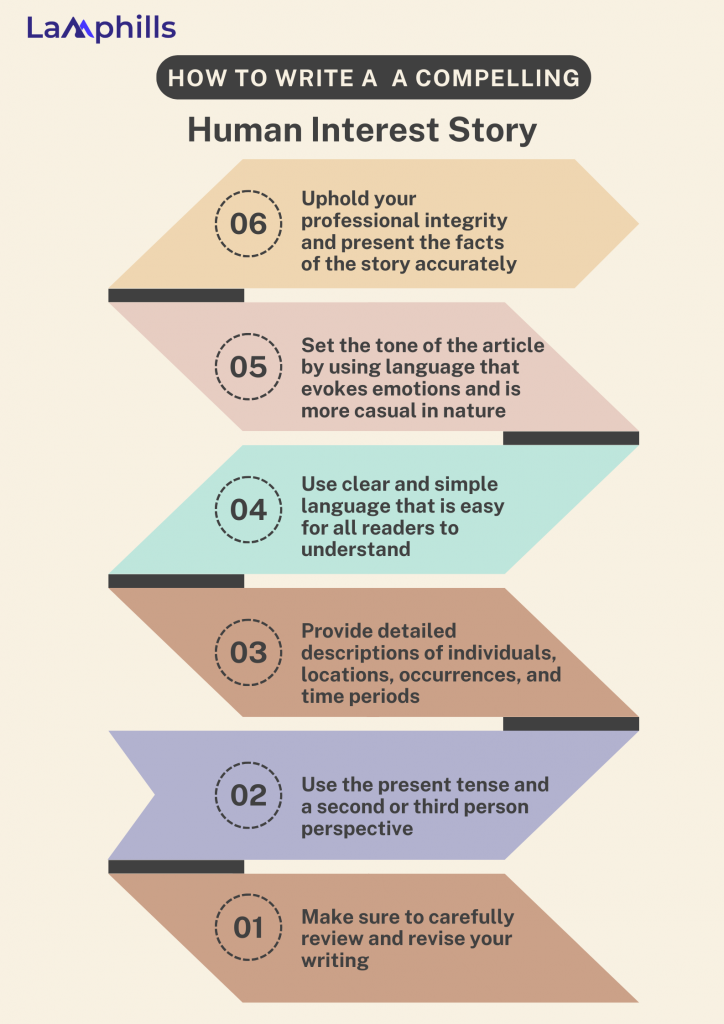Stories about people have a special way of grabbing attention and stirring up emotions. We call these compelling narratives “human interest stories.”
But writing captivating human interest stories is tough. Finding powerful stories, conducting insightful interviews, and weaving it all together in a way that resonates is always overwhelming.
As someone who has been in the storytelling game for a while, I know the hurdles.
The good thing, however, is that I’m here to be your guide. Let’s break down the key ingredients for crafting human interest pieces.
With this approach, you’ll be able to create human stories that hit readers right in the feels and stay with them long after.
Key Points
- The main purpose of a human interest story is to elicit an emotional reaction and connection from the reader.
- Human interest stories allow the writer to establish atmosphere and background while also providing the reader with a deeper knowledge of why individuals behave as they do and how they feel about their experiences. The writing should provide rich context about the subjects.
- The delayed lead is a common introduction style in human interest stories. It contributes to atmosphere and context by drawing the reader in and not revealing the theme until several paragraphs into the story. Using a delayed lead can build intrigue.
- Create a fast yet semi-detailed draft once you’ve agreed on a structure. Organizing the details and quotes helps with later drafts. Organizing details and quotes upfront is advised for longer stories.
- More significantly, write about how the person impacted the world and why that is relevant today and in the future. Tying the story’s relevance to the present/future is important.
What Constitutes a Human Interest Story?
A human interest story is a narrative that places people at the center of events, designed to capture attention and evoke empathy by allowing readers to identify with the subjects, their challenges, and experiences. Unlike traditional news reporting that focuses solely on facts and figures, human interest stories connect with audiences on an emotional level by highlighting the personal aspects of events and issues.
The fact is that people are important to any human interest story. It is people telling their unique tales dynamically and engagingly. Whether it’s overcoming adversity, raising awareness, or opening up about a disease or experience to help educate others, stories of outstanding human achievement, acts of bravery, unsung heroes, victims, or hilarious stories, the emphasis is always on the individual and their story.
For this purpose, the individual should always be the main character.
The benefit of narrating this narrative is that the reader can relate emotionally. An excellent human interest tale elicits emotions such as wrath, empathy, compassion, sympathy, motivation, humour, fear, and love. Not in equal measure, but if a journalist can check off all of these boxes, the article will be a hit, with a high likelihood of being shared and engaged. The primary goal is to move someone with.
The Basics of Writing a Human Interest Story
A human interest article focuses on the people and/or events at the heart of breaking news. It humanizes hard news. Human interest stories make events more relatable to us than they would otherwise be.
There are two categories of human-interest stories:
- Stories centred on humans
- Stories centred on events
On the other hand, there are five typical themes in human interest stories. The themes are
- Life’s small ironies
- Animal stories.
- Change of fortune.
- Lost children
- Romantic excursion.
Themes in human interest stories are essential because they symbolize societal myths. A myth is a socially perceived concept. The issue with myths in popular culture is that they frequently distort the genuine meaning of something. The goal of the human interest story is to confront such myths and help discover the humanistic perspective underlying them.
Unlike hard news stories, which frequently deal with ‘knowns,’ human interest stories regularly deal with ‘unknowns’. They bring everyday people’s tales to light, allowing journalists to bring a significant event down to a more relatable level for the public.
Still talking about the basics of writing human interest stories, here are two other important elements.
#1. Language Style for the Human Interest Story
The language employed is more emotive and intimate; the goal is to personalize the news by emphasizing its more personal and human elements. In this way, it is a tale about the human condition.
Human interest stories also allow you as the writer to establish atmosphere and background while also providing the reader with a deeper knowledge of why individuals behave as they do and how they feel about their experiences.
This type of news story should be written in the first person, allowing the author to place oneself within the story.
#2. Writing Structure of a Human Interest Story
Like hard news and feature stories, human interest stories should express timeliness, neutrality, and accuracy. It does not use the inverted pyramid style of a hard news article but rather resembles a feature and follows the usual story format.
The delayed lead is a common introduction style in human interest stories. It contributes to atmosphere and context by drawing the reader in and not revealing the theme until many paragraphs into the story.
Some Guidelines for Writing a Human Interest Story
Here are some guidelines to keep in mind when writing a human interest story. I know they work because I use them each time i have a human interest story to write.
- Obtain all the possible facts and details.
- Be specific.
- Research and use a lot of quotes.
- Interview
- Use anecdotes to personalize events depending on the subject’s experiences.
- Have a theme
How To Write a Human Interest Story.pdf
How to Structure a Human Interest Story
1. Create a Compelling Headline and Lead
Create a captivating and brief headline and lead that effectively describes the story.
An effective lead is crucial in capturing readers’ attention and encouraging them to continue reading. Create a captivating headline that will immediately capture the interest of your readers, seamlessly leading them into the rest of the lead. Provide a concise overview of your story and offer readers a glimpse of what they can anticipate in the subsequent sections.
Begin by sharing a concise anecdote about the individual in question. One possible approach is to include details about the interviewee’s initial interaction or their interaction with their pet prior to the interview.
2. Ensure that all relevant information are Included in the Body Text
After establishing the context, it is important to narrate the story in a chronological manner. Provide them with the pertinent information you have gathered and incorporate compelling narrative elements that will captivate their interest. Don’t worry about crafting an inverted pyramid-style article; human interest pieces should have a more literary feel rather than a strictly journalistic one.
Also, keep your message brief. If you have a multitude of interviews and statements at your disposal for quoting, it is advisable to minimize your word count as much as possible.
3. Craft a concise introduction
An introductory paragraph clarifies the purpose of interviewing the individual whose quotes are highlighted in your article. Introduce your readers to the individuals and provide further insight into their credibility, experience, and the relevance of their perspective to the piece.
The nut graf is crucial in helping readers grasp the interviewee’s achievements and their significance.
4. Craft a well-structured conclusion.
Compose a concise summary elucidating the global impact or significance of the subject of your article. When addressing an individual, it is important to delve into their aspirations, ambitions, and concerns on a personal level.
For instance, you can craft a conclusion that outlines the future political aspirations of the local activist you interviewed. This conclusion should provide specific details about their intended agenda and the changes they aim to bring about once in office.
You can also to end your story with a powerful quote that highlights the main message of the story.
How to Write a Compelling Human Interest Story

1. Use the present tense and a second or third person perspective
Writing in the present tense and using the second or third point of view is recommended.
Human interest stories are most effective when written in the present tense as it allows readers to feel fully immersed in the moment as they read. When considering a point of view, third-person is frequently used in articles, but utilizing second-person can make your article more distinctive.
Describing something in the present tense gives the impression that it is happening right now.
2. Provide detailed descriptions of individuals, locations, occurrences, and time periods.
Employ vivid and evocative language to immerse your readers in the setting you are describing. Use the valuable insights from your research to craft comprehensive descriptions. Provide sufficient detail to paint a vivid picture in the readers’ minds, allowing them to envision the entire scene without actually witnessing it firsthand.In reference to the provided source.
Instead of stating the fact, “The sun is setting,” consider describing the scene as, “The setting sun fills the sky with a beautiful palette of red and orange hues.” Her angular features are complemented by soft, wavy hair, and she possesses captivating brown eyes…
Also, use a diverse range of vocabulary to enhance your writing. Incorporate colorful language, clever wordplay, or catchy phrases if they come to mind. It is acceptable to adopt a more artistic approach, diverging from the conventional style found in typical news articles.
3. Use clear and simple language that is easy for all readers to understand
Write using plain and uncomplicated language that can be easily understood by all readers.
Complex terminology can pose a challenge for readers who are unfamiliar with the topic at hand. It is advisable to refrain from using overly specialized terminology that may only be understood by a particular audience. However, if it becomes necessary to employ technical or specific language, it is important to provide a clear explanation the first time it is introduced.
4. Set the tone of the article by using language that evokes emotions and is more casual in nature
Employ a conversational and casual tone to establish the atmosphere of the story.
Establish an engaging tone in your writing by gradually evoking emotions in both the introduction and main body, ultimately reaching a powerful conclusion. Human interest stories aim to evoke emotions while providing information, allowing for the use of terms that set the desired tone for the reader.
5. Uphold your professional integrity and present the facts of the story accurately
Avoid the temptation to exaggerate the facts! Objective language is preferred in a human interest piece, ensuring that the story is portrayed accurately. Find a middle ground between the emotional aspect of the piece and the factual information that should be included.Changing the account of events or facts undermines the credibility of the entire story. It is possible to convey your viewpoint, employ persuasive language, and captivate your audience while staying true to the facts!
6. Make sure to carefully review and revise your writing
Before submitting your human interest story, it’s essential to give it a thorough proofread and edit. Take a break from your article and give yourself a chance to relax. When you come back to it, approach it with a renewed perspective. Please review the article for any spelling or grammatical errors, as well as ensuring consistency in the tone and emotions portrayed in the story.
Double-check your story to make sure you haven’t included any inaccurate information.
Consider the main theme of the story and the feelings you previously identified. Were they conveyed in the manner you intended? If you think that altering the presentation could have a greater impact on the readers, you may consider revising the piece.
6 Ways to Enhance the Appeal of a Human-Interest Story
1. Take the time to thoroughly read the entire story
Before diving into the editing process, it’s crucial to take the time to thoroughly read the story, paying close attention to every detail. Select the key points you want to emphasize. This will assist you in identifying the key aspect of the story. Which part is the most important? What can evoke a strong emotional response from the readers? Could this be considered a story of overcoming challenges? Or perhaps a different perspective? Or perhaps a tale of fostering optimism?
2. Prioritize the emotional aspect
Keep the story concise and avoid overwhelming it with excessive details. It is crucial to establish an emotional connection with your reader right from the start. However, ensuring the accuracy of the information is absolutely essential. That doesn’t imply that the story must solely revolve around information. When selecting the appropriate emotion, construct the narrative around it, using the information as supporting elements within the overall structure.
3. Use information to create vivid character descriptions
When using the information at your disposal, it is important to ensure that it is presented cohesively and does not come across as fragmented pieces of data. Instead, the information should assist you in developing the character and understanding the context. The reader should be able to visualize the character and their reality based on how you present the information.
By conducting some research and incorporating additional details from reliable sources, you can enhance the credibility of your story.
Consider including relevant historical, political, or economic background information about the location, as well as specific details about any incidents, disasters, crises, or pandemics that the character has experienced and that are relevant to the story. Providing a detailed description of the situation, their houses, and their economic condition can help readers establish a stronger connection.
4. Again provide ample details without resorting to exaggeration
The draft you have in your possession is an extremely preliminary version that requires careful consideration. The information and details included in that story are presented in a straightforward manner. As an editor, it’s important to take it to the next level. You need to put in more effort than just making minor adjustments. All the details require some additional attention. Refine the sentences, if necessary, by adding words that highlight the details and make them more powerful. However, it is crucial to exercise caution to prevent any potential exaggeration. Readers have a keen ability to disengage when they detect excessive emphasis in a narrative.
5. Experiment with the order of the sequences
What is the initial event in the narrative? What’s the challenge? What about the present? Challenging times in the past? Or is it the aspiration of the future? You make your decision based on the merit of each sequence and place them accordingly. There’s nothing wrong with having some fun! Additionally, it can prevent monotony, particularly when tackling a sequence of narratives.
6. Don’t overlook the importance of staying positive
Readers have their own challenges to deal with. Consequently, concluding with an optimistic tone instills hope in readers, both for the fictional character and their own lives. This is precisely what we desire. Creating a sense of personal connection with your readers. It’s important to leave readers with a positive impression, ideally putting a smile on their face when they reach the end. Whenever possible, it’s important to emphasize the positive aspects and conclude the story on a positive note. We all strive for a sense of optimism as the day draws to a close. We all strive for success and victory in the final stretch!
What are examples of human interest stories?
A human interest narrative could be an inspiring story about children raising money for charity or a factual story about a pet saving its owner.
More examples of human interest stories include:
- Stories of Resilience such as a person overcoming a physical disability to achieve a challenging goal, a community coming together to support a family after a natural disaster and an individual battling a serious illness with a positive attitude.
- Stories of Everyday Heroes such as a teacher making a significant impact on their students’ lives, a volunteer dedicating their time to helping the homeless, a person performing a selfless act of kindness.
- Stories of life changing moments such as the Baby Teddy’s Legacy. He was the world’s youngest organ donor at just minutes old. A human interest story on him Inspired 15,000 people to register as NHS donors and transformed tragedy into hope for others
How do you start a human interest story?
The first step in creating a news story with human interest is to select an angle that ties your topic to the individuals affected by it. This entails identifying a person or group who can represent your news story’s topic, problem, solution, or outcome.
What are the characteristics of a human interest story?
In journalism, a human-interest story is an emotionally charged feature piece about people or pets. It depicts people and their difficulties, concerns, or triumphs so the reader or viewer is interested, sympathized with, or motivated.
What is the difference between human interest stories and other stories?
There is a significant distinction between human interest stories and hard news stories: human interest stories are about individuals, whereas hard news stories are often about events. It’s a human interest narrative, so the attention is on the human!
Conclusion
Most media news consists of rapid, breaking items to keep you interested and informed (hard news). However, now and then, a writer is allowed to write a human interest article (soft news) for their media source. Certain parts must flow smoothly together for your feature article to build a significant connection with its readers. Hence, knowing how to approach a correct tale structure and tone will allow you to develop an excellent and instructive narrative that will elicit an emotional response from the audience.
Related Articles
- Top Media Outlets in 2024: A Trustworthy Guide for Authoritative News Sources
- CONTENT MARKETING: A User-Guide to Developing Your Business
- Is Communications a Good Major? All You Need to Know
- Social Media Engagement: 7 Interactive Post Ideas That Helped Us.





